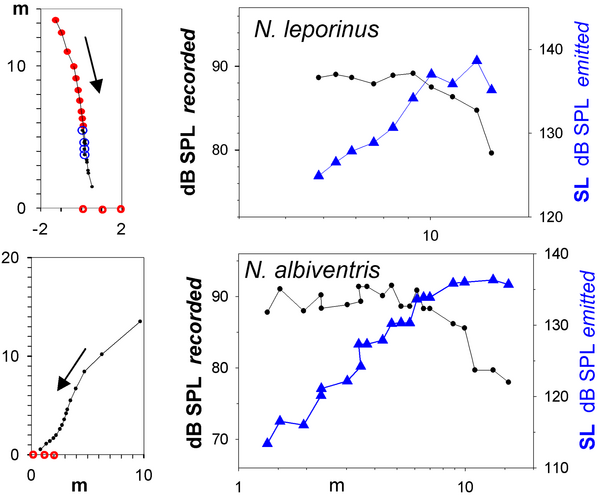Using microphone arrays and photographic methods to reconstruct flight paths of bats in the field when they find and capture prey in air using their sonar system, Annemarie Surlykke from the Institute of Biology, SDU, Denmark, and her colleague, Elisabeth Kalko, from the University of Ulm, estimated the emitted sound intensity and found that bats emit exceptionally loud sounds exceeding 140 dB SPL (at 10 cm from the bat's mouth), which is the highest level reported so far for any animal in air.
For comparison, the level at a loud rock concert is 115-120 dB and for humans, the threshold of pain is around 120 dB.(1)

Bats emit their echolocation calls at ultrasonic frequencies, i.e. above the human hearing range. This is necessary to get echoes from small insects, but the draw-back of high frequencies is that they do not carry far in air as they are attenuated faster than low frequencies. By estimating detection range for typical insect prey, Surlykke and Kalko conclude that these extreme intensities are essential for the bats as they serve to counteract attenuation.
Their examination of the echolocation behavior in 11 species of insect-eating tropical bats from Panamá is the first comparative field study of bat echolocation sounds focusing on intensity and the results revealed, very interestingly, that although signal intensities (and frequencies) of bats vary widely, they appear to converge on similar detection ranges, because the bats emitting the highest frequencies were also the bats emitting the highest intensities.
Thus, the study illustrates the value of an interdisciplinary approach combining bat biology, ecology, behavioral biology and acoustics.
(1) Who concert reference may not be relevant to anyone under the age of 40. Trust us, they were louder than a 747 and Pete Townshend definitely has tinnitus.
Citation: Surlykke A, Kalko EKV (2008) Echolocating Bats Cry Out Loud to Detect Their Prey. PLoS ONE 3(4): e2036. doi:10.1371/journal.pone.0002036






Comments